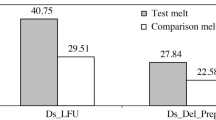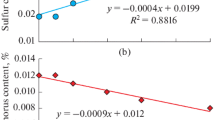The technological process of steel smelting at “ArcelorMittal Temirtau” JSC includes three stages: converter smelting of semi-finished products, ladle treatment, and continuous casting of slabs. According to the current technology, a desired flowability of the refining slag is created in the ladle-furnace unit by thinner additives, such as fluorspar. When using fluorspar, toxic fluorine emissions aggravate the environmental situation at the worksite. In addition, the presence of fluoride compounds in the slag adversely affects the durability of the ladle lining. Without modifying the technological process and the consumption of slag-forming agents (lime), solid slag mixtures, based on aluminum oxide, can be used in the ladle-furnace unit to eliminate fluorine emissions into the workshop atmosphere, neutralize the negative effect on the resistance of the ladle lining slag belt, as well as reduce the cost of steel due to the refusal of fluorspar and reduced consumption of aluminum for slag deoxidization.







Similar content being viewed by others
References
O. A. Bannykh, P. B. Budberg, S. P. Alisova, et al., Diagram of States for Dual and Multicomponent Iron-Based Systems [in Russian], Moscow, Metallurgiya, (1986).
V. G. Voskoboinikov, V. A. Kudrin, and A. M. Yakushev, General Metallurgy [in Russian], Textbook , 6th Ed., Rev. and Add., IKTs “Akademkniga,” Moscow (2005).
V. M. Kolokol’tsev, A. P. Kotok, and K. A. Dolbilov, “The sulfur problem of foundry steels,” Vest. Magnitogorskogo Gos. Tekhn. Un-ta im. G. I. Nosova, No. 3(47), 30–32 (2014).
V. M. Goritskii, M. A. Lushkin, O. V. Goritskii, and A. M. Kulyomin, “Influence of the sulfur content and structure on the toughness anisotropy coefficient of structural steels (using Menage samples),” Zavod. Labor. Diagnos. Mater., 80, No. 4, 38–42 (2014).
S. P. Rudenko, A. L. Val’ko, and V. N. Parfenchik, “Influence of sulfur on the anisotropy of the plastic properties of structural steels,” Stal’, No. 2, 46-49 (2018).
E. A. Krylova, A. M. Stolyarov, V. V. Moshkunov, and M. V. Potapova, “Chemical heterogeneity of a continuously cast slab of a sulfur suprapure pipe steel,” Teor. Tekhnol. Metallurg. Proizv., No. 1(20), 20–22 (2017).
S. Endo, M. Nagae, Y. Kovayashi, and K. Ume, “Suifide stress corrosion cracking in welded joints of welded linepipe,” ISIJ International, 34, No. 2, 217–223 (1994).
I. I. Reformatskaya, “Influence of structure-forming factors on the corrosion and electrochemical behavior of iron and stainless steels,” Rossiiskii Khimicheskii Zhurnal (Zhurnal Rossiiskogo Khimicheskogo Obshchestva im. D. I. Mendeleeva), LII, No. 5, 16–24 (2008).
M. Elboujdaini and R.W. Revie, “Metallurgical factors in stress corrosion cracking (SCC) and hydrogen-induced cracking (HIC),” J. Solid State Electrochem., 13, 1091–1099 (2009).
L. V. Lagutina and A. M. Rubashov, “Influence of the sulfur content on the corrosive behavior of carbon steels in network water,” Teploenergetika, No. 7, 28–31 (1995).
Sh. Frank, V. D. B. Bart, and V. H. Gvido, “Comparison of the leading methods for the cast iron desulphurization,” Teor. Tekhnol. Metallurg. Proizv., No. 1(16), 38–43 (2015).
A. F. Shevchenko, A. S. Vergun, A. M. Shevchenko, and I. A. Manachin, “Sulfur content in cast iron and steels when using the cast iron desulfurization prior the steel smelting,” Chernaya Metallurgiya: Byul. NTiEI, No. 5 (1373), 47-50 (2014).
A. F. Shevchenko, A. S. Vergun, B. V. Dvoskin, V. G. Kislyakov, L. P. Kurilova, V. A. Aleksandrov, A. M. Bashmakov, D. Y. Lyu, and R. J. Yan, “Influence of the iron desulphurization and slag skimming on the sulphur input into the steelmaking unit,” Chernaya Metallurgiya: Byul. NTiEI, No. 5 (1301), 18-25 (2008).
S. N. Ushakov, V. A. Bigeev, A. M. Stolyarov, and A. B. Sychkov, “Features of producing converter steel with an ultra-low sulfur content: Physicochemical foundations of metallurgical processes,” Sb. Tr. Mezhd. Nauch. Konf. Posvyashchennoi 115-Letiyu so Dnya Rozhdeniya Akad. A.M. Samarina, 69 (2017).
S. N. Ushakov, V. A. Bigeev, A. M. Stolyarov, and M. V. Potapova, “Ladle desulfurization of converter low-sulfur pipe steel,” Metallurgist, 62, No. 7/8, 667–673 (2018).
V. A. Bigeev, A. M. Stolyarov, Yu. A. Kolesnikov, A. B. Sychkov, and M. V. Potapova, “Converter production of low-sulfur pipe steel,” in: Sbornik: Nauch.-Tekhn. Progress v Chernoi Metallurgii - 2017, Mater. III Mezhd. Nauch. Konf. [in Russian], Res. Ed. M. A. Timofeeva (2017), pp. 27–33.
V. A. Bigeev, A. O. Nikolaev, A. V. Brusnikova, “Features of producing low-sulfur steel with a limited hydrogen content,” Stal’, No. 4, 18–20 (2014).
E. V. Parusov, A. B. Sichkov, L. V. Sagura, and I. N. Chuiko, “Ensuring an ultra-low sulfur content during the laddle treatment of steel,” Nauch. Tr. Vinnitskogo Nats. Tekhn. Un-ta, No. 1, 12-17 (2017).
S. V. Zhuravleva, Yu. S. Paniotov, and V. S. Mameshin, “Evaluation of the LF metal desulphurization treatment according to the bivariate mechanism,” Metall i Lit’e Ukrainy, No. 2(261), 8–11 (2015).
G. I. Kotel’nikov, A. E. Semin, R. S. Kulish, S. A. Motrenko, and Yu. Apunov, “Temperature dependence of the metal desulfurization in steelmaking units,” Elektrometallurgiya, No. 8, 15–18 (2010).
M. I. Gasik, M. M. Gasik, A. P. Gorobets, O. I. Polyakov, Yu. S. Proidak, A. I. Panchenko, and A. S. Sal’nikov, “Analysis of the oxide-fluoride melt stability during the steel electrometallurgical refining,” Metallurgiya i Gornorudnaya Promyshlennost’, No. 5, 20–29 (2011).
E. Andersson and Du. Sichen, “The effect of CaF2 in the slag in ladle refining,” Steel Research International, 80, No. 8, 544–551 (2009).
H. Berg and R. Gerling, “Influence of the ladle treatment on the wear of steel casting ladle lining,” Chernye Metally, No. 6, 27–32 (2005).
Author information
Authors and Affiliations
Corresponding author
Additional information
Translated from Metallurg, Vol. 67, No. 8, pp. 13–17, August, 2023.
Rights and permissions
Springer Nature or its licensor (e.g. a society or other partner) holds exclusive rights to this article under a publishing agreement with the author(s) or other rightsholder(s); author self-archiving of the accepted manuscript version of this article is solely governed by the terms of such publishing agreement and applicable law.
About this article
Cite this article
Zolin, A.N., Dobromilov, A.A., Esilbaev, R.D. et al. Application of Solid Slag Mixtures Based on Aluminum Oxide in Smelting Low-Sulfur Steels. Metallurgist 67, 1078–1085 (2023). https://doi.org/10.1007/s11015-023-01599-w
Received:
Revised:
Accepted:
Published:
Issue Date:
DOI: https://doi.org/10.1007/s11015-023-01599-w




